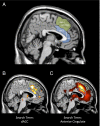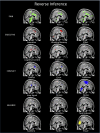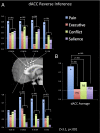The dorsal anterior cingulate cortex is selective for pain: Results from large-scale reverse inference
- PMID: 26582792
- PMCID: PMC4679028
- DOI: 10.1073/pnas.1515083112
The dorsal anterior cingulate cortex is selective for pain: Results from large-scale reverse inference
Abstract
Dorsal anterior cingulate cortex (dACC) activation is commonly observed in studies of pain, executive control, conflict monitoring, and salience processing, making it difficult to interpret the dACC's specific psychological function. Using Neurosynth, an automated brainmapping database [of over 10,000 functional MRI (fMRI) studies], we performed quantitative reverse inference analyses to explore the best general psychological account of the dACC function P(Ψ process|dACC activity). Results clearly indicated that the best psychological description of dACC function was related to pain processing--not executive, conflict, or salience processing. We conclude by considering that physical pain may be an instance of a broader class of survival-relevant goals monitored by the dACC, in contrast to more arbitrary temporary goals, which may be monitored by the supplementary motor area.
Keywords: Neurosynth; dACC; pain; reverse inference.
Conflict of interest statement
The authors declare no conflict of interest.
Figures







Comment in
-
Reply to Wager et al.: Pain and the dACC: The importance of hit rate-adjusted effects and posterior probabilities with fair priors.Proc Natl Acad Sci U S A. 2016 May 3;113(18):E2476-9. doi: 10.1073/pnas.1603186113. Epub 2016 Apr 19. Proc Natl Acad Sci U S A. 2016. PMID: 27095848 Free PMC article. No abstract available.
-
Pain in the ACC?Proc Natl Acad Sci U S A. 2016 May 3;113(18):E2474-5. doi: 10.1073/pnas.1600282113. Epub 2016 Apr 19. Proc Natl Acad Sci U S A. 2016. PMID: 27095849 Free PMC article. No abstract available.
References
-
- MacLean PD. Brain evolution relating to family, play, and the separation call. Arch Gen Psychiatry. 1985;42(4):405–417. - PubMed
-
- Vogt BA, Finch DM, Olson CR. Functional heterogeneity in cingulate cortex: The anterior executive and posterior evaluative regions. Cereb Cortex. 1992;2(6):435–443. - PubMed
-
- Carter CS, Botvinick MM, Cohen JD. The contribution of the anterior cingulate cortex to executive processes in cognition. Rev Neurosci. 1999;10(1):49–57. - PubMed
-
- Wager TD, Smith EE. Neuroimaging studies of working memory: A meta-analysis. Cogn Affect Behav Neurosci. 2003;3(4):255–274. - PubMed
-
- Garavan H, Ross TJ, Murphy K, Roche RA, Stein EA. Dissociable executive functions in the dynamic control of behavior: Inhibition, error detection, and correction. Neuroimage. 2002;17(4):1820–1829. - PubMed
MeSH terms
LinkOut - more resources
Full Text Sources
Other Literature Sources
Medical

